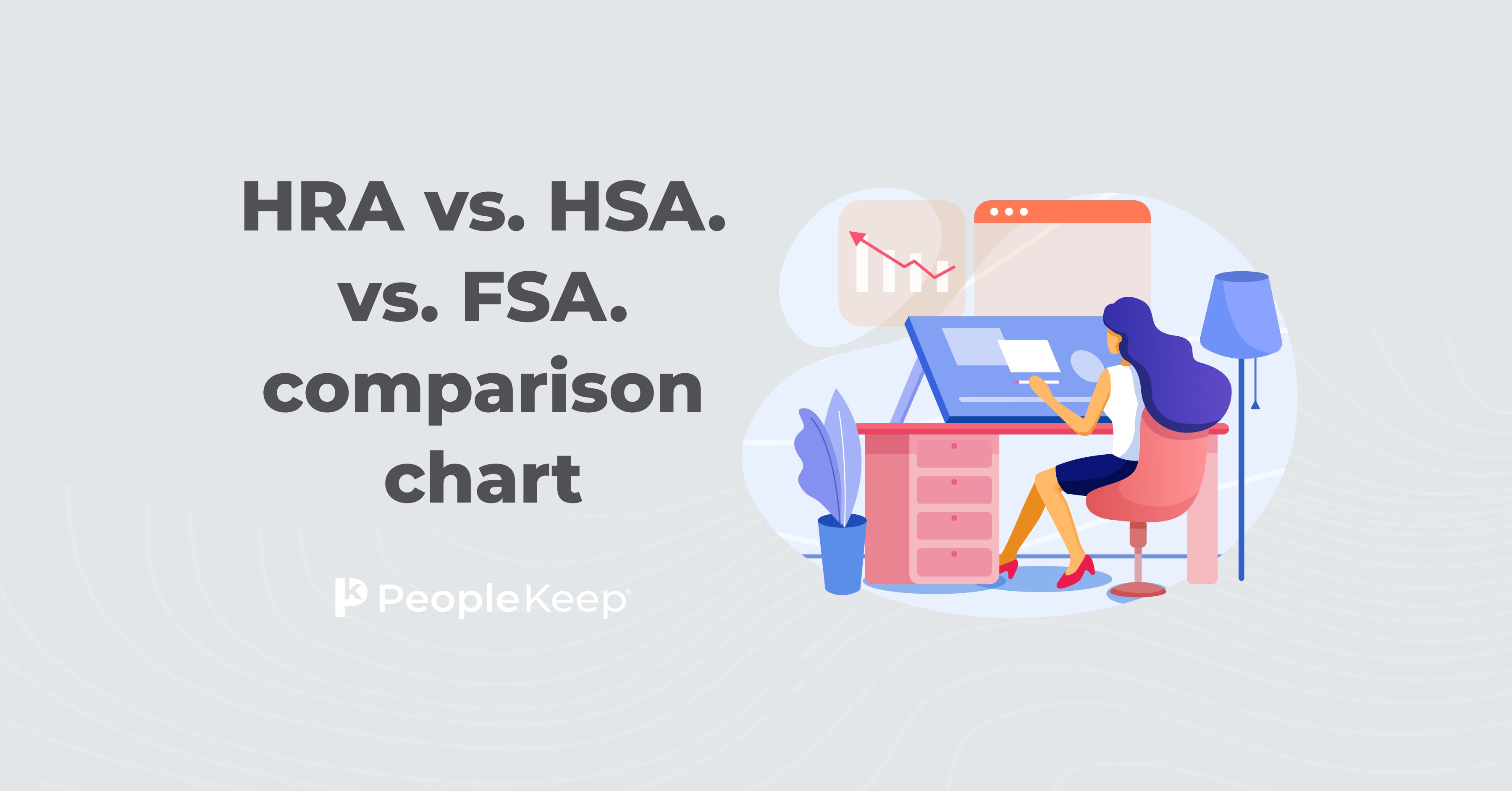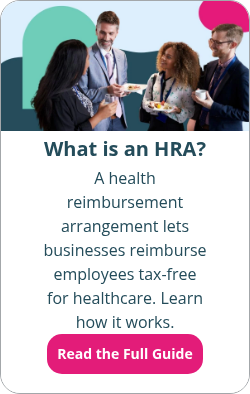10 health reimbursement arrangement FAQs
By Elizabeth Walker on April 25, 2025 at 8:15 AM
A health reimbursement arrangement (HRA) is becoming an increasingly popular option for small and midsized employers. These employer-funded health benefits help small businesses offer cost-effective, flexible benefits. Employees also gain more control over their healthcare decisions.
HRAs must follow similar regulations as other tax-advantaged health benefits, like health savings accounts (HSAs) and flexible spending accounts (FSAs). But they also come with unique rules and requirements that employers need to understand.
In this blog post, we've answered the 10 most frequently asked questions about HRAs to help you get started.
In this blog post, you’ll learn:
- What an HRA is and how it helps business owners reimburse employees tax-free for medical expenses.
- The different types of HRAs and how each one works based on company size and insurance needs.
- Answers to common HRA questions, such as who can contribute and what happens to unused funds.
What is an HRA?
An HRA is a tax-advantaged health benefit that enables employers to reimburse employees for qualified out-of-pocket medical care expenses. Depending on the type of HRA you offer, individual health insurance premiums may also be eligible for reimbursement.
While they're sometimes called health reimbursement accounts, an HRA doesn’t require employers to pre-fund it like other account-based health plans. Employers define a monthly allowance of tax-free money employees can spend on medical care.
When employees buy an eligible health insurance policy or other medical services and items, they submit proof of the expense. Once the employer or HRA administrator reviews the claim, the employer schedules tax-free reimbursement up to the employee’s available allowance. They typically do this on the employee’s next paycheck.
The three types of HRAs that PeopleKeep by Remodel Health offers are:
- The individual coverage HRA (ICHRA). The ICHRA is for all employer sizes. But, only employees with qualified individual health insurance coverage can take part in the benefit. There are no maximum contribution limits with an ICHRA. Employers can also set different allowance amounts for 11 classes of employees or by family status. For example, they can offer part-time workers $350 per month and full-time employees $650.
- The qualified small employer HRA (QSEHRA). Sometimes called the small business HRA, this HRA is for small employers with fewer than 50 full-time equivalent employees (FTEs) that don't offer a traditional group health plan. All W-2 full-time employees are automatically eligible for a QSEHRA, and the IRS sets annual maximum contribution limits. Employees must have a health plan with minimum essential coverage (MEC) to use the benefit. This means employees with coverage through a spouse’s or parent’s group plan can still participate in the QSEHRA.
- The group coverage HRA (GCHRA). Also known as an integrated HRA, the GCHRA is for employers of all sizes that offer traditional group health plans. Only employees enrolled in their employer's group health plan can use the HRA. Like ICHRA, it has no maximum annual limits. You can also differ allowances by job-based criteria. PeopleKeep offers customizable by seven employee classifications. By law, group plan premiums are ineligible for reimbursement.
10 HRA FAQs
If you're considering offering your workforce an HRA or are just curious about how they work, let's review 10 frequently asked questions about the benefit.
1. Do employees have to have health insurance coverage to participate in an HRA?
Yes, employees need a qualifying health plan to participate in an HRA. Depending on the type of HRA an employer offers, that may be individual health insurance coverage—whether self-only or family coverage through the public or private exchange—or an employer's group plan.
For example, if an employer offers a QSEHRA, an employee must have MEC to participate. This can be through an individual health insurance plan or coverage through a spouse’s or parent’s group health plan.
If an employer offers an ICHRA, an employee can't use it without an individual health insurance plan with MEC. During the Open Enrollment Period, employees can choose the best healthcare coverage for themselves. They can also change or sign up for new coverage during a special enrollment period if they experience a qualifying life event.
Integrated HRAs require employees to participate in an employer's traditional group health plan to take advantage of the benefit.
Other HRAs, like the one-person stand-alone HRA, the retiree HRA, and the excepted benefit HRA (EBHRA), don't require employees to have qualified health plan coverage to participate.
2. Who owns an HRA—the employer or the employee?
HRAs are employer-owned, unlike HSAs, which the individual employee owns. HSAs also aren't tied to employment, whereas HRAs are.
Because the employer owns the HRA and it isn’t a savings account, employees can't withdraw funds from their HRA's allowance to pay for qualified medical care expenses directly. They must first pay for the item or service out of pocket. Then, their employer must verify and approve it before reimbursing the employee.
3. Who can contribute to an HRA?
According to IRS regulations, only employers can contribute to HRAs. Federal laws don’t allow participants in the HRA to contribute. This distinction often gets confused with HSAs and FSAs, which are accounts that allow for both employee and employer contributions.
HRA allowances and reimbursements also don't count toward an employee’s gross income. Reimbursements are income tax-free for eligible employees.
4. How much can an employer contribute to an HRA?
The employer determines the allowance amount. But some HRAs, like the QSEHRA and the EBHRA, have annual maximum contribution limits defined by the IRS. Your HRA plan documents should outline the limits for your employees’ awareness.
In 2026, small businesses with a QSEHRA can offer up to $6,450 for self-only employees ($537.50 per month) and $13,100 for employees with a family ($1,091.66 per month). If you have an EBHRA, the 2026 annual limit is $2,200.
The ICHRA and the GCHRA don't have any maximum contribution limits. So, employers can offer as little or as much allowance as they wish.
5. Does the money in an HRA earn interest?
An HRA doesn't earn interest like a regular bank account or an HSA. Remember, employers maintain them on an unfunded basis and only pay money out as reimbursements once employees and eligible dependents make an eligible purchase.
Employers or HRA administrators must verify and approve the expenses per IRS regulations. So, they're unable to earn interest.
6. Does an HRA roll over from year to year?
If you want to roll over your HRA funds annually, it'll depend on the type of HRA you have and how the employer sets up the benefit.
For instance, QSEHRA allowance amounts can roll over monthly or yearly. However, QSEHRAs have annual contribution limits, so the total allowance amount plus the rolled-over amount from the previous year can't exceed the maximum limit.
One-person HRAs, stand-alone HRAs, or integrated HRAs can roll over monthly and annually if the business owner chooses to allow them.
Sometimes, rollover capabilities depend on the HRA software that’s administering the benefit. For example, PeopleKeep’s HRA administration software only allows funds to roll over monthly.
Check out our full blog on HRA roll over guidelines for more information.
7. What does an HRA cover?
Under IRS regulations, HRA funds can only reimburse employees for eligible healthcare expenses defined in IRS Publication 5021 and the CARES Act. Only the employee, their spouse, and eligible dependents can incur eligible medical expenses for reimbursement during the HRA's plan year.
A few examples of eligible expenses under an HRA include:
- Individual health insurance premiums
- Deductibles, coinsurance costs, and copayments
- Vision and dental expenses
- Over-the-counter medicines, like pain relievers or acne treatment
- Prescription drugs
- Preventive services
- Diagnostic services
The type of HRA an employer offers can sometimes restrict what expenses qualify for reimbursement. For example, EBHRAs and GCHRAs can't reimburse health insurance premiums. Additionally, an employer can limit what expenses they want to allow for reimbursement, even if the IRS lists the items as eligible.
Examples of ineligible expenses include:
- Items or services that an employer's HRA plan documents or explanation of benefits (EOB) don’t define as eligible
- Items or services that the IRS doesn’t list in Publication 502
- Items or services an employee, their spouse, or eligible dependents incur before their HRA's coverage effective date
- Items or services employees have already received reimbursement for from alternative sources, such as an HSA or FSA
- General nutrition, wellness, and health items or services that the IRS doesn’t consider medical expenses3
- The expense can be eligible for tax-free reimbursement with an HRA if the employee provides a letter of medical necessity for the item.
8. Can employees use HRA funds to pay for their family's medical expenses?
Yes, HRA funds can pay for eligible medical expenses of an employee’s spouse and any dependent on their federal tax return. Per the IRS, if an employee and their spouse or partner are legally married and their HRA covers dependents, they can submit their family members’ expenses for reimbursement just like they would their own eligible expenses. Family members need to meet the eligibility requirements for the benefit, such as having individual health insurance coverage for an ICHRA.
If an eligible employee has a QSEHRA with PeopleKeep and their employer has enabled the employer-sponsored premium reimbursement (ESPR) feature, they receive a bonus. ESPR allows employees to receive reimbursement for their spouse's traditional group health insurance premiums.
However, these reimbursements will be taxable because their spouse is most likely paying the monthly premium for the policy through payroll deductions on a pre-tax basis.
9. What is the maximum reimbursement under an HRA?
Employees are eligible for reimbursement up to their allowance amount. Employers should outline the allowance amount in the HRA's plan documents. Additionally, the employer may increase or decrease the maximum reimbursement amount annually.
Employers don’t have to provide employees with the maximum available allowance amount (if they have an HRA with an allowance cap, such as a QSEHRA. They also don’t have to give the same amount as the previous year if an employee has an HRA with unlimited allowance capabilities, like an ICHRA or GCHRA.
10. What happens to unused HRA funds?
Because an HRA is employer-owned, most HRAs are only for current employees. Unused funds stay with an employer if an employee quits, is laid off, or retires. This is unlike employee-owned HSAs, where unused funds go with workers even if they change jobs.
Employees also can't “cash out” any remaining allowance funds before they leave a job since an HRA isn't pre-funded and allowances aren’t available to the employee until they buy an eligible service or item.
However, an employer may allow a 90-day grace period for employees to submit reimbursement requests for any medical care expenses they incurred while employed. Additionally, retiree-only HRAs allow retired employees to use contributed funds after they retire.
Conclusion
Whether you’re hearing about the HRA for the first time or determining whether to offer one as your company’s health benefit, understanding some basic facts is the first step. By doing some deeper analysis, you’ll understand why this personalized health benefit is an excellent alternative to traditional health plans.
With HRA funds, you can give employees the ability to have their insurance premiums and out-of-pocket medical costs covered, keeping them financially steady throughout rising healthcare costs. The better you understand how an HRA works, the greater the value your team can receive from it.
This article was originally published on July 16, 2012. It was last updated on April 25, 2025.
2. CARES Act
3. Companies misrepresenting nutrition, wellness, and general health expenses as medical care for HRAs
Check out more resources
See these related articles

HRAs and W-2 annual reporting
Learn about HRA W-2 annual reporting requirements. Understand what employers need to include on employees' W-2 forms for HRA compliance.

HRA vs. HSA vs. FSA comparison chart
Confused about the differences between an HRA, HSA, and FSA? This comparison chart breaks down the key features of each health benefit option.

Can I have an HRA and an FSA at the same time?
Learn if you can have an HRA and an FSA at the same time. Understand the rules, benefits, and how these accounts can work together for healthcare costs.



